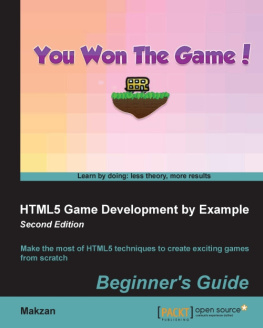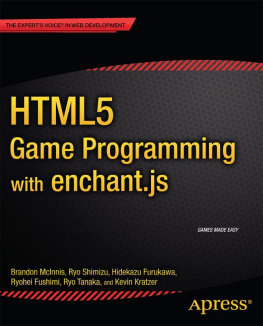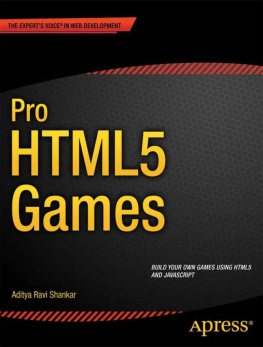Rex van der Spuy [Rex van der Spuy] - The Advanced Game Developer’s Toolkit: Create Amazing Web-based Games with JavaScript and HTML5
Here you can read online Rex van der Spuy [Rex van der Spuy] - The Advanced Game Developer’s Toolkit: Create Amazing Web-based Games with JavaScript and HTML5 full text of the book (entire story) in english for free. Download pdf and epub, get meaning, cover and reviews about this ebook. year: 2017, publisher: Apress, genre: Computer. Description of the work, (preface) as well as reviews are available. Best literature library LitArk.com created for fans of good reading and offers a wide selection of genres:
Romance novel
Science fiction
Adventure
Detective
Science
History
Home and family
Prose
Art
Politics
Computer
Non-fiction
Religion
Business
Children
Humor
Choose a favorite category and find really read worthwhile books. Enjoy immersion in the world of imagination, feel the emotions of the characters or learn something new for yourself, make an fascinating discovery.
- Book:The Advanced Game Developer’s Toolkit: Create Amazing Web-based Games with JavaScript and HTML5
- Author:
- Publisher:Apress
- Genre:
- Year:2017
- Rating:4 / 5
- Favourites:Add to favourites
- Your mark:
The Advanced Game Developer’s Toolkit: Create Amazing Web-based Games with JavaScript and HTML5: summary, description and annotation
We offer to read an annotation, description, summary or preface (depends on what the author of the book "The Advanced Game Developer’s Toolkit: Create Amazing Web-based Games with JavaScript and HTML5" wrote himself). If you haven't found the necessary information about the book — write in the comments, we will try to find it.
Master the most important skills and techniques you need to know for professional HTML5 and JavaScript 2D game development. This book delves into many of the great classic techniques of video game design.
Youll discover how to develop games and game levels using Tiled Editor, how to implement tile-based collision, how to design advanced pathfinding and enemy AI systems, the fundamentals of broad-phase collision, and how to make isometric games. All the techniques and supporting code are explained in an easy-to-understand manner and written in a general way so that they can be applied to any game engine or technology that youre comfortable using.
Youll find detailed working examples, with dozens of illustrations and many concepts you can freely apply to your own projects. All the math and programming techniques are elaborately explained and examples are open-ended to encourage you to think of original ways to use these techniques in your own games. You can use what you learn in this book as the basis for making games for desktops, mobile phones, tablets, or the Web.The Advanced Game Developers Toolkit is a great next step if you already have some JavaScript game-making- experience, or a great continuation if youve already read Advanced Game Design with HTML5 and JavaScript by the same author.
What Youll Learn
- Work with advanced tile-based design techniques for puzzle, platform and maze games
- Use Tiled Editor to build game worlds
- Build path-finding and AI systems using Line of Sight and A* (A-Star)
- Make isometric games
- Manage complexity to build games of any size that scale seamlessly
Who This Book Is For
Rex van der Spuy [Rex van der Spuy]: author's other books
Who wrote The Advanced Game Developer’s Toolkit: Create Amazing Web-based Games with JavaScript and HTML5? Find out the surname, the name of the author of the book and a list of all author's works by series.

![Rex van der Spuy [Rex van der Spuy] The Advanced Game Developer’s Toolkit: Create Amazing Web-based Games with JavaScript and HTML5](/uploads/posts/book/121403/thumbs/rex-van-der-spuy-rex-van-der-spuy-the-advanced.jpg)
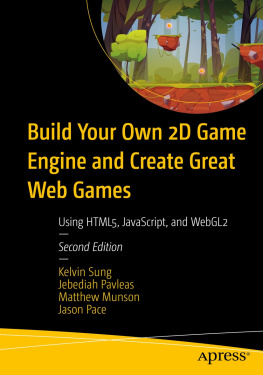


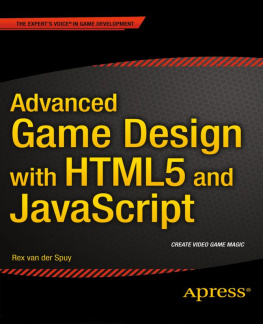
![Aditya Ravi Shankar [Aditya Ravi Shankar] - Pro HTML5 Games](/uploads/posts/book/121402/thumbs/aditya-ravi-shankar-aditya-ravi-shankar-pro.jpg)
![Graeme Stuart [Graeme Stuart] - Introducing JavaScript Game Development : Build a 2D Game from the Ground Up](/uploads/posts/book/121400/thumbs/graeme-stuart-graeme-stuart-introducing.jpg)
![Rex van der Spuy [Rex van der Spuy] - Foundation Game Design with HTML5 and JavaScript](/uploads/posts/book/121398/thumbs/rex-van-der-spuy-rex-van-der-spuy-foundation.jpg)
